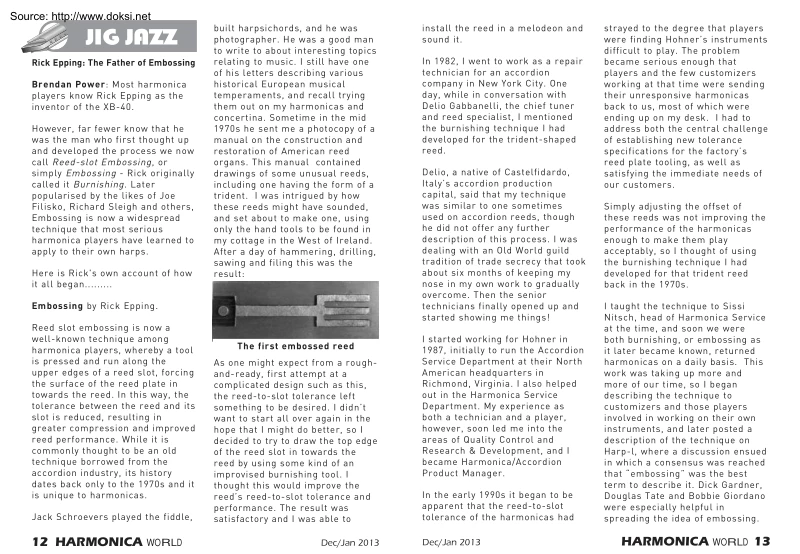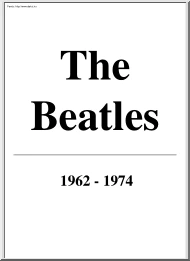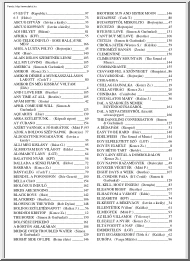Datasheet
Year, pagecount:2013, 2 page(s)
Language:English
Downloads:2
Uploaded:April 05, 2018
Size:501 KB
Institution:
-
Comments:
Attachment:-
Download in PDF:Please log in!
Comments
No comments yet. You can be the first!Most popular documents in this category
Content extract
Source: http://www.doksinet JIG JAZZ Rick Epping: The Father of Embossing Brendan Power: Most harmonica players know Rick Epping as the inventor of the XB-40. However, far fewer know that he was the man who first thought up and developed the process we now call Reed-slot Embossing , or simply Embossing - Rick originally called it Burnishing . Later popularised by the likes of Joe Filisko, Richard Sleigh and others, Embossing is now a widespread technique that most serious harmonica players have learned to apply to their own harps. Here is Ricks own account of how it all began. built harpsichords, and he was photographer. He was a good man to write to about interesting topics relating to music. I still have one of his letters describing various historical European musical temperaments, and recall trying them out on my harmonicas and concertina. Sometime in the mid 1970s he sent me a photocopy of a manual on the construction and restoration of American reed organs. This manual
contained drawings of some unusual reeds, including one having the form of a trident. I was intrigued by how these reeds might have sounded, and set about to make one, using only the hand tools to be found in my cottage in the West of Ireland. After a day of hammering, drilling, sawing and filing this was the result: Embossing by Rick Epping. Reed slot embossing is now a well-known technique among harmonica players, whereby a tool is pressed and run along the upper edges of a reed slot, forcing the surface of the reed plate in towards the reed. In this way, the tolerance between the reed and its slot is reduced, resulting in greater compression and improved reed performance. While it is commonly thought to be an old technique borrowed from the accordion industry, its history dates back only to the 1970s and it is unique to harmonicas. Jack Schroevers played the fiddle, 12 HARMONICA WORLD The first embossed reed As one might expect from a roughand-ready, first attempt at a
complicated design such as this, the reed-to-slot tolerance left something to be desired. I didn’t want to start all over again in the hope that I might do better, so I decided to try to draw the top edge of the reed slot in towards the reed by using some kind of an improvised burnishing tool. I thought this would improve the reed’s reed-to-slot tolerance and performance. The result was satisfactory and I was able to Dec/Jan 2013 install the reed in a melodeon and sound it. In 1982, I went to work as a repair technician for an accordion company in New York City. One day, while in conversation with Delio Gabbanelli, the chief tuner and reed specialist, I mentioned the burnishing technique I had developed for the trident-shaped reed. Delio, a native of Castelfidardo, Italy’s accordion production capital, said that my technique was similar to one sometimes used on accordion reeds, though he did not offer any further description of this process. I was dealing with an Old World guild
tradition of trade secrecy that took about six months of keeping my nose in my own work to gradually overcome. Then the senior technicians finally opened up and started showing me things! I started working for Hohner in 1987, initially to run the Accordion Service Department at their North American headquarters in Richmond, Virginia. I also helped out in the Harmonica Service Department. My experience as both a technician and a player, however, soon led me into the areas of Quality Control and Research & Development, and I became Harmonica/Accordion Product Manager. In the early 1990s it began to be apparent that the reed-to-slot tolerance of the harmonicas had Dec/Jan 2013 strayed to the degree that players were finding Hohner’s instruments difficult to play. The problem became serious enough that players and the few customizers working at that time were sending their unresponsive harmonicas back to us, most of which were ending up on my desk. I had to address both the central
challenge of establishing new tolerance specifications for the factory’s reed plate tooling, as well as satisfying the immediate needs of our customers. Simply adjusting the offset of these reeds was not improving the performance of the harmonicas enough to make them play acceptably, so I thought of using the burnishing technique I had developed for that trident reed back in the 1970s. I taught the technique to Sissi Nitsch, head of Harmonica Service at the time, and soon we were both burnishing, or embossing as it later became known, returned harmonicas on a daily basis. This work was taking up more and more of our time, so I began describing the technique to customizers and those players involved in working on their own instruments, and later posted a description of the technique on Harp-l, where a discussion ensued in which a consensus was reached that “embossing” was the best term to describe it. Dick Gardner, Douglas Tate and Bobbie Giordano were especially helpful in
spreading the idea of embossing. HARMONICA WORLD 13 Here is an image of an embossed Source: http://www.doksinet harmonica reed: At this time I thought, based on the scant information provided to me by Delio Gabbanelli, that I had simply reinvented an old accordion technique. When first passing it on to others I described it as such. A few years later I learned that the process which was sometimes used on accordion reeds is very different. Instead of embossing, or burnishing the upper reed slot edge, a narrow line is stamped, or coined onto the upper surface of the reed frame, a short distance away from the slot’s edge. Coined accordion reed plate Coined accordion in detail As with reed slot embossing, reed plate coining results in a decrease in reed-to-slot tolerance, except that, while embossing only narrows the slot at the surface, coining results in the reed slot being narrowed through a greater depth of the reed plate, with the slot’s edges remaining untouched. 14
HARMONICA WORLD The indentations just back from the reed slot edge, the ones that look like a dotted line, are what I refer to as the coining. Stamping tools, such as those used to make reed slots, wear with use and need to be routinely re-sharpened. This often results in some dimensional variance in the tooling and consequently in the produced parts, which can affect the reed-to-slot tolerance. All the pieces in any particular production run will be pretty much the same. The coining process can correct any such variance, keeping the finished reed plate within the specified tolerance. My guess is that a sample reed frame and reed tongue are stamped out and then measured to determine their reed-to-slot tolerance. The pressure on the coining tool is then adjusted so that it will force the reed slot together enough to achieve the specified reed-to-slot tolerance. After this, all the reed frames for this particular reed’s production run are coined. Finally, the reed tongues are riveted
to the coined reed frames to complete the assembled reed plate. Since introducing the technique of embossing to the harmonica community, I have had the satisfaction of seeing it spread worldwide, become standard practice in custom harmonica work, and help players in raising their harmonica performance capabilities to the level we enjoy today. Thanks, Jack
contained drawings of some unusual reeds, including one having the form of a trident. I was intrigued by how these reeds might have sounded, and set about to make one, using only the hand tools to be found in my cottage in the West of Ireland. After a day of hammering, drilling, sawing and filing this was the result: Embossing by Rick Epping. Reed slot embossing is now a well-known technique among harmonica players, whereby a tool is pressed and run along the upper edges of a reed slot, forcing the surface of the reed plate in towards the reed. In this way, the tolerance between the reed and its slot is reduced, resulting in greater compression and improved reed performance. While it is commonly thought to be an old technique borrowed from the accordion industry, its history dates back only to the 1970s and it is unique to harmonicas. Jack Schroevers played the fiddle, 12 HARMONICA WORLD The first embossed reed As one might expect from a roughand-ready, first attempt at a
complicated design such as this, the reed-to-slot tolerance left something to be desired. I didn’t want to start all over again in the hope that I might do better, so I decided to try to draw the top edge of the reed slot in towards the reed by using some kind of an improvised burnishing tool. I thought this would improve the reed’s reed-to-slot tolerance and performance. The result was satisfactory and I was able to Dec/Jan 2013 install the reed in a melodeon and sound it. In 1982, I went to work as a repair technician for an accordion company in New York City. One day, while in conversation with Delio Gabbanelli, the chief tuner and reed specialist, I mentioned the burnishing technique I had developed for the trident-shaped reed. Delio, a native of Castelfidardo, Italy’s accordion production capital, said that my technique was similar to one sometimes used on accordion reeds, though he did not offer any further description of this process. I was dealing with an Old World guild
tradition of trade secrecy that took about six months of keeping my nose in my own work to gradually overcome. Then the senior technicians finally opened up and started showing me things! I started working for Hohner in 1987, initially to run the Accordion Service Department at their North American headquarters in Richmond, Virginia. I also helped out in the Harmonica Service Department. My experience as both a technician and a player, however, soon led me into the areas of Quality Control and Research & Development, and I became Harmonica/Accordion Product Manager. In the early 1990s it began to be apparent that the reed-to-slot tolerance of the harmonicas had Dec/Jan 2013 strayed to the degree that players were finding Hohner’s instruments difficult to play. The problem became serious enough that players and the few customizers working at that time were sending their unresponsive harmonicas back to us, most of which were ending up on my desk. I had to address both the central
challenge of establishing new tolerance specifications for the factory’s reed plate tooling, as well as satisfying the immediate needs of our customers. Simply adjusting the offset of these reeds was not improving the performance of the harmonicas enough to make them play acceptably, so I thought of using the burnishing technique I had developed for that trident reed back in the 1970s. I taught the technique to Sissi Nitsch, head of Harmonica Service at the time, and soon we were both burnishing, or embossing as it later became known, returned harmonicas on a daily basis. This work was taking up more and more of our time, so I began describing the technique to customizers and those players involved in working on their own instruments, and later posted a description of the technique on Harp-l, where a discussion ensued in which a consensus was reached that “embossing” was the best term to describe it. Dick Gardner, Douglas Tate and Bobbie Giordano were especially helpful in
spreading the idea of embossing. HARMONICA WORLD 13 Here is an image of an embossed Source: http://www.doksinet harmonica reed: At this time I thought, based on the scant information provided to me by Delio Gabbanelli, that I had simply reinvented an old accordion technique. When first passing it on to others I described it as such. A few years later I learned that the process which was sometimes used on accordion reeds is very different. Instead of embossing, or burnishing the upper reed slot edge, a narrow line is stamped, or coined onto the upper surface of the reed frame, a short distance away from the slot’s edge. Coined accordion reed plate Coined accordion in detail As with reed slot embossing, reed plate coining results in a decrease in reed-to-slot tolerance, except that, while embossing only narrows the slot at the surface, coining results in the reed slot being narrowed through a greater depth of the reed plate, with the slot’s edges remaining untouched. 14
HARMONICA WORLD The indentations just back from the reed slot edge, the ones that look like a dotted line, are what I refer to as the coining. Stamping tools, such as those used to make reed slots, wear with use and need to be routinely re-sharpened. This often results in some dimensional variance in the tooling and consequently in the produced parts, which can affect the reed-to-slot tolerance. All the pieces in any particular production run will be pretty much the same. The coining process can correct any such variance, keeping the finished reed plate within the specified tolerance. My guess is that a sample reed frame and reed tongue are stamped out and then measured to determine their reed-to-slot tolerance. The pressure on the coining tool is then adjusted so that it will force the reed slot together enough to achieve the specified reed-to-slot tolerance. After this, all the reed frames for this particular reed’s production run are coined. Finally, the reed tongues are riveted
to the coined reed frames to complete the assembled reed plate. Since introducing the technique of embossing to the harmonica community, I have had the satisfaction of seeing it spread worldwide, become standard practice in custom harmonica work, and help players in raising their harmonica performance capabilities to the level we enjoy today. Thanks, Jack





 When reading, most of us just let a story wash over us, getting lost in the world of the book rather than paying attention to the individual elements of the plot or writing. However, in English class, our teachers ask us to look at the mechanics of the writing.
When reading, most of us just let a story wash over us, getting lost in the world of the book rather than paying attention to the individual elements of the plot or writing. However, in English class, our teachers ask us to look at the mechanics of the writing.